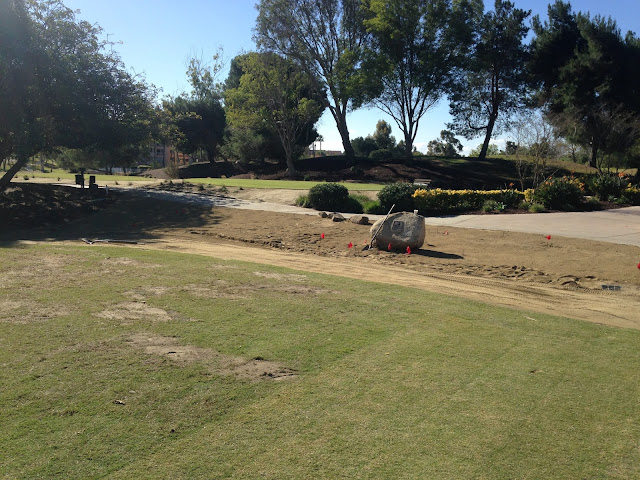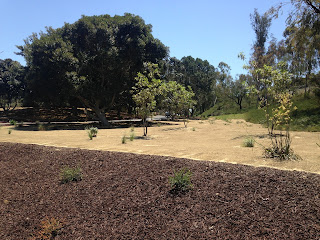Last Saturday, the club hosted a session we call Office Hours, which is a short presentation followed by a Q&A dealing with course conditions and maintenance. Today, I'd like to share a summary of the topics discussed for those of you who were not able to attend.
For the new subscribers, this post is many times longer than a normal post. We covered a massive amount of information, much of it fairly technical. I'll try to keep this as short as possible.
Fairways
Yes, this is the main topic of debate at Bernardo Heights Country Club and for obvious reasons. There are many thin lies in the fairways since bermuda is not growing well during the winter months. We just passed the worst of it with five days of heavy frost near New Years Day. Some members are wondering why the fairways look this way however I'd like to explain why the fairways have never been better positioned for the future.
The bermuda fairways are young; some have only been pure bermuda for four months. By pure bermuda, I mean that there is no other grass growing in the fairway. There is no perennial ryegrass leftover from our overseeding days and there is no Poa annua that has been allowed in during winter months. Most of our fairways are pure bermuda and will only get better as temperatures increase.
The par 3's and holes 13 and 15 have not been sprayed to eliminate the cool season grasses, but they will very shortly. By the end of this summer, we will have 100% bermuda fairways. We have made it past the ugly conversion stage and can now enjoy the maturing process that will produce the carpet-like bermuda we've been waiting for. I've been smiling lately because it's closer than you think.
Take a look at this picture of the fairway on #2 that I took this morning:
Now compare it to a photo taken on the 14th of January just a few weeks ago:
Hopefully you see a difference and an improvement. We've moved from a two grass cycle to bermuda year-round. Overseeding is really successful in Palm Springs, but we are not Palm Springs. We do not receive a return on a ryegrass investment. It is much better to suffer for a month or two and enjoy excellent conditions the rest of the time. Once the bermuda is matured and filled in, by the end of this summer, next winter will not be so bad at all. We originally promoted the fairway conversion as a three year process back in 2012 and we are right on time. Get ready for some beautiful fairways this year.
Greens
Just like the majority of golf courses in San Diego, our greens are mostly Poa annua. This includes Torrey Pines, Rancho Sante Fe, and San Diego Country Club. I would love to play those greens on a daily basis. Stop being afraid of Poa because it is truly a remarkable putting surface.
The greens at Bernardo Heights are starting to roll very well with the bentgrass waking up with warmer temperatures. We have a blend of bentgrass and Poa, and they are really starting to even out and blend together. Soon, we will begin light topdressing to fill slight imperfections and the occasional verticut to control puffiness. This morning, greens were rolling around 10.5, a bit faster than they've been in previous weeks. We plan on keeping the greens between 10.5 and 11 on the stimp meter, a very reasonable speed for our greens.
Sodium issues that come about from our irrigation water are under control, especially with the nice rains we received in December. We need more of those rains to flush salts through the root zone. Toward the end of last summer, we changed the way we flush greens and now feel we have a good handle on this practice. Read about that and some changes to the fertilizer program in this previous blog post:
Adjustments to the Greens Program
Collars
Another major topic at Saturday's meeting was the condition of the collars around the greens. We have paspalum collars and have to live with that grass type for now. In the winter, this turf will go dormant and lose a lot of it's leaf tissue. This results in a very thin stand of turf, sometimes right down to the soil. Last year, we scalped the collars down to the soil and overseeded with ryegrass. This made the collars look nice, but they did not play very well at all. There are varying opinions on this year's strategy of using colorants and no seeding, but the overall consensus is the collars play better this way. The paspalum is beginning to green up again and we are mowing it low to knock down the tufts of ryegrass leftover from last year's seeding.
The collars just passed the center of winter and low point of growth potential. Like the bermuda fairways, they will only get greener and smoother as temperatures warm.
Well Water
We've been tracking the water level of our new well since last May and readings have been very positive. In May of 2014, the water sat 310 feet below the ground. The fracture from which we pull water sits at 980 feet. Our pump sits at 600 feet below ground. The last reading, taken on January 30th was up to 307 feet below the surface, three feet higher than May of last year.
We are committed to maintaining this source of water in a sustainable fashion. Without overseeding, we will be using very little water throughout the cooler months. We have and will continue to remove turf from areas out of play. Over five acres were removed from the irrigation grid over the last two years and we are exploring a turf reduction program to remove up to an additional 15 acres.
Water quality is not excellent, but it is manageable. Regular water tests have shown the well water to have the same amount of sodium and bicarbonates (bad things for turf) as when we first started drawing water. We expect the levels of salts to remain constant and we have found the proper maintenance practices to grow turf in spite of less than perfect water.
Since the time the well was put into operation, the club has saved over $560,000 minus electricity costs. We also have saved the City of San Diego over 90 million gallons of water by utilizing an untapped source of water that would not be useful in most situations. I think we can be proud of this investment, both for the dollar savings and the reduction of the draw on our drinking supply. Water is a precious resource and we are dedicated to using every drop as efficiently as possible.
Rough
Now that the rough is back on the fertilizer program and undesirable grasses are being removed, we are getting very close to where we want to be. Last Monday, I sprayed over two acres of rough with a product that will eliminate ryegrass tufts. We will continue to spot fertilize thin spots and push our bermuda stand. Once we eliminate the tufts that cause most of the bad lies, we will have nothing standing in our way.
Summary
You may be hearing a common theme in most of these sections: ryegrass is in our way. Overseeding has caused us many pains. The bermuda was weak, bare spots emerged in late summer, and a huge cost was imposed on the club for good winter conditions. San Diego's winter is so short, it kinda blends with the other seasons and today, it was 80 degrees.
We have direction now. The fairways will be bermuda. The rough will be bermuda. The green surrounds will be….. you guessed it, bermuda. This grass type takes less water, handles sodium, and can provide excellent playing conditions year round.
For the last two years, half of my job has been killing turf. I'm good at it. If we never get rid of the ryegrass and poa that have starved the bermudagrass, the conversion can never take place. Well, we are almost out of grass to kill.
To wrap up the longest blog post I've written in five years, I like where we are sitting right now. We have a stable water source that saves us money. We've converted to a grass that wants to grow here. We have a fantastic layout and some members who really love being here. And shame on me for not mentioning my wonderful staff last Saturday or until the final section of the blog. They care about this course, they are really excited about the bermuda fairways, and they are the best Turf Maintenance Soccer Team in San Diego.
Thanks for reading.
 The back tier of the driving range tee has been shrinking for years. The usable practice area was limited by a landscaped bed at the back of the tee, costing us nearly a week of playable turf. In early August, we removed the palms in that bed and started to prepare the tee for new sod.
The back tier of the driving range tee has been shrinking for years. The usable practice area was limited by a landscaped bed at the back of the tee, costing us nearly a week of playable turf. In early August, we removed the palms in that bed and started to prepare the tee for new sod.  Further improvements to the area include the renovation of the space between the driving range and the tee complex for the first hole. We removed some large and overgrown birds of paradise bushes and will be planting over fifty drought tolerant plants matching the rest of our new landscape. Decomposed granite will replace the turf that used to cover this area, providing a clean look and multiple access points between practice area and the first tee.
Further improvements to the area include the renovation of the space between the driving range and the tee complex for the first hole. We removed some large and overgrown birds of paradise bushes and will be planting over fifty drought tolerant plants matching the rest of our new landscape. Decomposed granite will replace the turf that used to cover this area, providing a clean look and multiple access points between practice area and the first tee. 




































